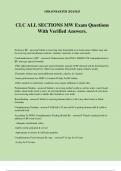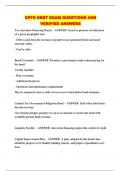©BRAINBARTER 2024/2025
CLC ALL SECTIONS MW Exam Questions
With Verified Answers.
Exclusive BF - answer✔-Infant is receiving only breastmilk as its food source (babies may also
be receiving oral rehydration solution, vitamins, minerals, or other oral meds)
Contraindications to BF* - answer✔-Galactosemia (the ONLY ABSOLUTE contraindication to
BF; must get special formula)
-PKU (phenylketonuria) (must get special formula, amount of BF allowed will be determined by
monitoring infants blood lvls. Other rare metabolic blood disds impact infant's needs)
-Premature infants may need additional minerals, calories, & vitamins
-Some professionals rec 400IU of vitamin D daily for BF infants
-Other medical or nutritional. conditions may require additions to infants diet
Predominant Feeding - answer✔-Infant is receiving mother's milk as well as water, water based
drinks, ritual foods (such as teas), & oral rehydration solutions, vitamins, minerals & oral meds.
(not receiving other foods or drinks like formula or cow milk)
Breastfeeding - answer✔-Infant is receiving human milk as well s any other foods or fluids
(formula)
Complimentary Feeding - answer✔-Child id 6-23 mos old & Is getting human milk & solid or
semisolid food.
According To WHO, Complimentary Feeding Should Be: - answer✔-Timely (starting foods in
addition to BF from 6 mos)
- Adequate (nutritional value)
-Safely stored, prepared & served
-Appropriate in texture & sufficient quantity
Complimentary Food Amount By Age: - answer✔-2x day for 6-8 mos
-3x day for 9-24 mos
, ©BRAINBARTER 2024/2025
-Additional snacks may be offered 1-3x daily
Why BF is Stopped - answer✔-Concerns about milk quality/quantity
-Feeding problems during 1st week
-Problems w/ infant latching or sucking
-Lack of appropriate info & support
Original 10 Steps to Successful BF (WHO/UNICEF 1989) - answer✔-1. Have written BF policy
that is communicated to all health care staff routinely.
-2. Train healthcare staff in skills necessary to implement the policy
-3. Inform pregnant women about benefits & management of BF
-4. Help moms initiate BF within 30 min of birth
-5. Show moms hwo to BF & how to maintain lactation, even if they are separated from baby
-6. Give newborn no food or drink other than BM, unless medically indicated
-7. Practice rooming in (24 hrs a day)
-8. Encourage BF on demand
-9. No pacifiers or artificial nipples to BF babies
-10. Foster establishment of BF support groups & refer moms to them on discharge
10 Steps to Successful BF (2018) - answer✔-**1-2 Critical Management Procedures
-1. (a.) Comply w/ International Code of Marketing of Breast-milk Substitutes & relevant World
Health Assembly resolutions
-1. (b.) Have written baby feeding policy that is routinely communicated to staff & parents
-1. (c.) Establish ongoing monitoring & data management systems
-2. Ensure that staff have sufficient knowledge, competence, & skills to support BF
-**3-10 Key Clinical Practices
-3. Discuss importance & management of BF w/ pregnant women & families
4. Facilitate immediate & uninterrupted skin-to-skin & support moms to initiate BF ASAP after
birth
-5. Support moms to initiate & maintain BF & manage common difficulties
-6. Do no provide BF newborn any food or fluids other than BM, unless medically indicated
, ©BRAINBARTER 2024/2025
-7. Enable moms & infants to remain together & practice rooming in 24 hrs a day
-8. Support moms to recognize & respond to infant's cues for feeding
-9. Counsel moms on the use & risks of feeding bottles, teats, & pacis
-10. Coordinate discharge so that parents and infants have timely access to ongoing support &
care
Step 1. (a.) Comply w/ International Code of Marketing of Breast-milk Substitutes & Relevant
World Health Assembly Resolutions - answer✔-Purpose: protect families from influence of
formula companies
-Background: the "Code" was adopted by World Health Assembly in 1981 to be implemented
internationally; however is it not in force in all nations; it requires implementation of those
aspects of the Code that fall within the facility's purview
-Global Standards: all infant feeding bottles use in facility have been purchased thru normal
channels and not received for free or subsidized supplies; facility has no display of products
covered under the Code or items w/ logos of formula companies, or names of formula products;
facility has policy describing how it abides by Code, including getting BM substitutes, not
accepting support/gifts from producers or distributors by products covered by the Code & not
giving sample of BM substitutes, feeding bottles, or teats; at least 80% of health professionals in
antenatal, delivery, or newborn care can explain at least 2 elements of the Code.
Step 1. (b.) Have written baby feeding policy that is routinely communicated to staff & parents -
answer✔-Purpose: ensure existence of evidence-based policy promoting BF & delineates
standards of care
-Global Standards: health facility has written infant feeding policy addressing implementation of
all 8 key clinical practices of the Ten Steps, Code implementation, & regular competency
assessment; observations in facility confirm that a summary of the policy is visible to pregnant
women, mothers, and families; review of clinical protocols/standards related to BF & infant
feeding used by maternity services indicates they are in line w/ BFHI standards & current EB
practices; at least 80% of clinical staff providing antenatal, delivery, or newborn care can explain
at least 2 elements of infant feeding policy that influence their role in facility.
Step 1. (c.) Establish ongoing monitoring & data management systems - answer✔-Purpose:
ensure the implementation of clinical practices supporting BF & related maternity care practices
is tracked & monitored routinely
-Global Standards: global guidance IDs specific indicators for each of the key clinical practices
(steps 3-10) including indicator definitions, targets, & data sources; facility has protocol for
ongoing monitoring & data management system to comply w/ the 8 key clinical practices;
clinical staff at facility meet at least every 6 mos to review implementation of the system
, ©BRAINBARTER 2024/2025
Step 2. Ensure that staff have sufficient knowledge, competence, & skills to support BF -
answer✔-Purpose: ensure all staff have training necessary to develop effective skill in supporting
BF families providing consistent messages & implement facility policies
-Global Standards: at least 80% of clinical staff providing antenatal, delivery, or newborn care
report they have received pre-service or in-service training on BF on the previous 2 years; at
least 80% of clinical staff providing antenatal, delivery, or newborn care report receiving
competency assessments in BF in previous 2 years; at least 80% of clinical staff providing
antenatal, delivery, or newborn care are able to correctly answer 3/4 q's on BF knowledge &
skills to support BF
Step 3. Discuss importance & management of BF w/ pregnant women & families - answer✔-
Purpose: ensure integration of messages about BF in prenatal education interchanges
-Global Standards: protocol for antenatal discussion of BF includes: importance of BF, global
recommendations on exclusive Bf for first 6 mos, risks of giving formula or other substitutes, &
fact that BF continues to be important after 6 mos; importance of immediated & sustained skin-
to-skin; importance of early initiation of BF; importance of rooming in; basics of good
positioning & attachment; recognition of feeding cues. At least 80% of moms who receive
prenatal care at facility report having receives prenatal counseling on BF and they are able to
adequately describe what was discussed about 2 of the topics listed above.
Step 4. Facilitate immediate & uninterrupted skin-to-skin & support moms to initiate BF ASAP
after birth - answer✔-Purpose: ensure early initiation of skin-to-skin for all infants (whether BF
or not) & support early initiation of BF when intended
-Global Standards: at least 80% of moms of term infants report skin-to-skin happened
immediately or within 5 min of birth & lasted 1 hour or more, unless documented medically
justifiable reasons for delayed contact; at least 80% of moms of term infants report babies were
put to breast within 1 hour of birth unless documented medically justifiable reasons.
Step 5. Support moms to initiate & maintain BF & manage common difficulties - answer✔-
Purpose: ensure ongoing BF support, assessment, & eval during maternity stay for term, preterm,
and sick newborns
-Global Standards: at least 80% of BF moms of term infants report someone on staff offered help
w/ BF within 6 hours of birth; at least 80% of moms of preterm or sick infants report having
been helped to express milk within 1-2 hours of birth; at least 80% of BF moms of term infants
are able to demonstrate how to position baby for BF and baby can suckle and transfer milk; at
least 80% of BF moms of term infants can describe at least 2 indicators of whether a BF baby
consumes adequate milk; at least 80% of moms of BF preterm & term infants can correctly
demonstrate or describe how to express BM.





